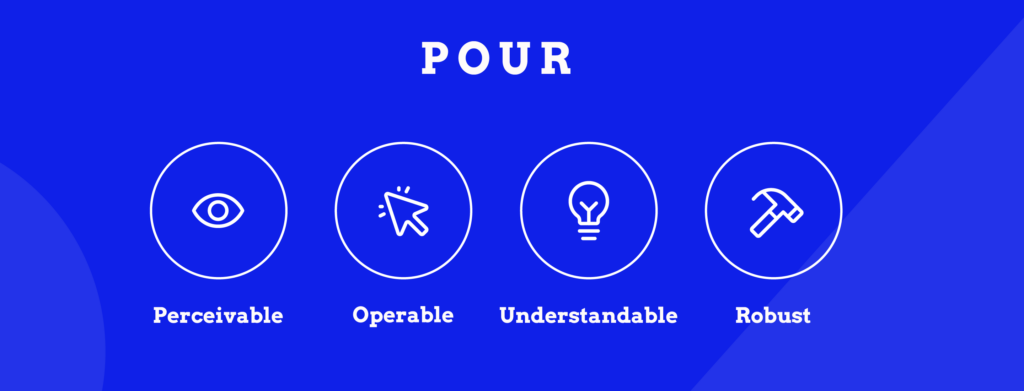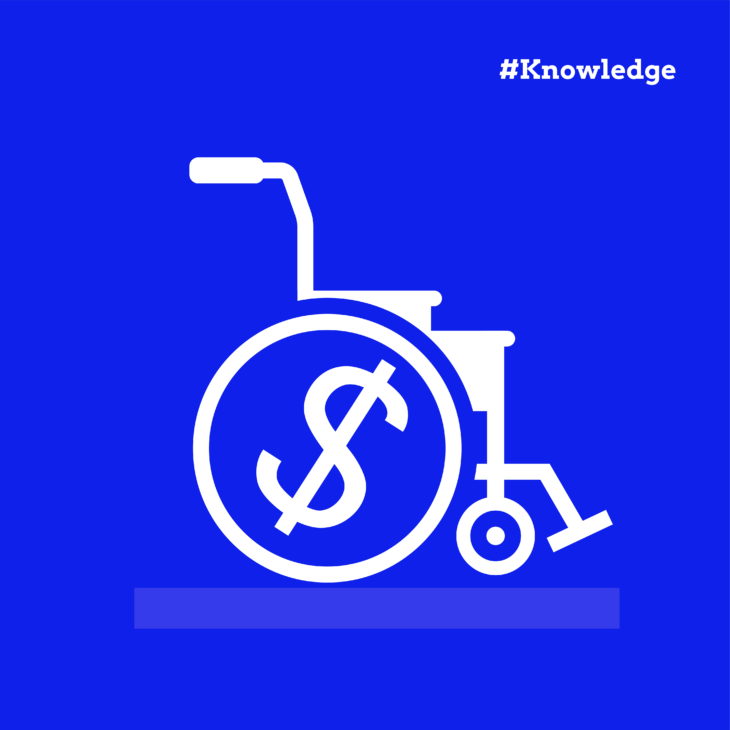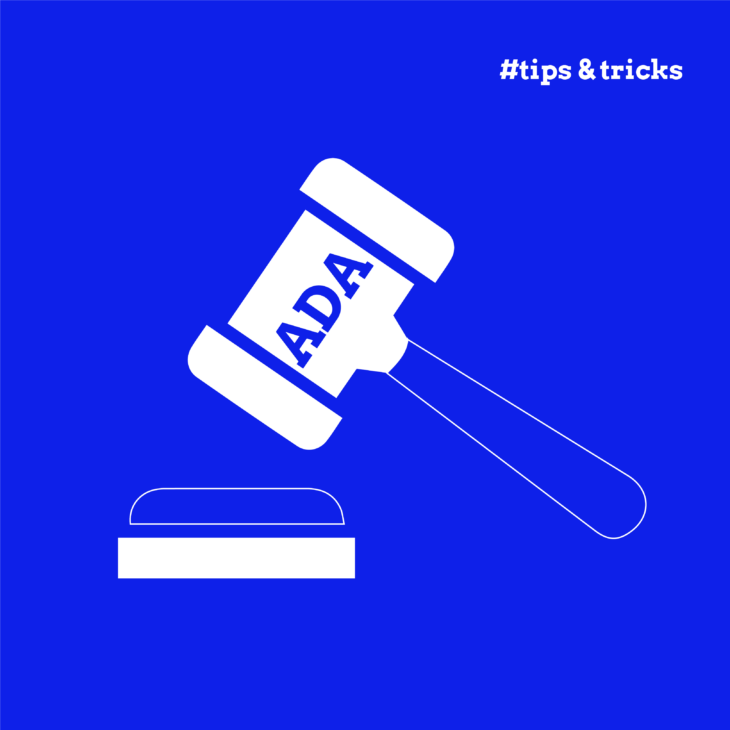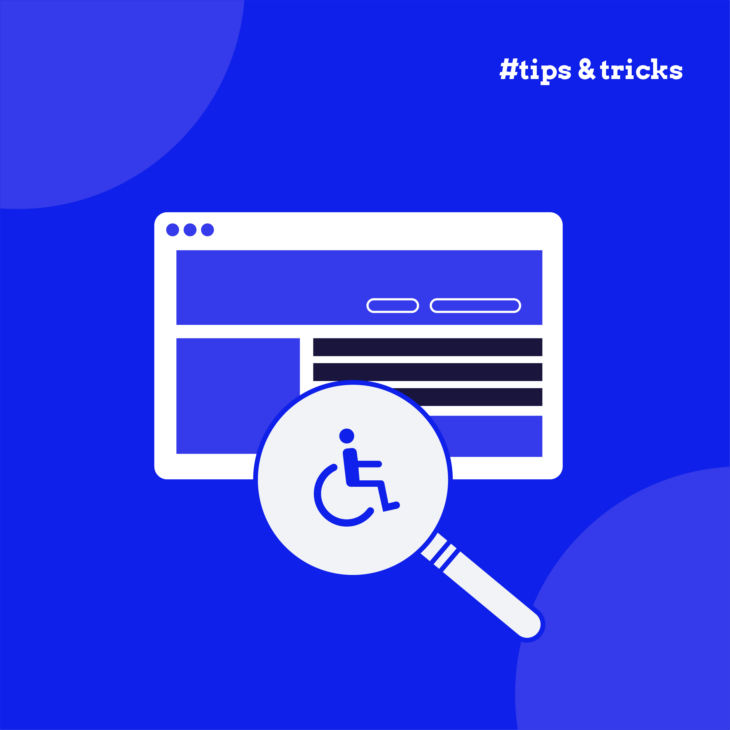Taeke Reijenga has extensive experience with the business side of Web Accessibility. As CEO of the full service digital agency Level Level, he has managed in a short amount of time to get his entire team on board when it comes to including web accessibility in their workflow.
Any decent person understands the need for web accessibility. Still, in recent years, it’s become more than just showing that we care about our fellow human beings – it’s also a business necessity. The WebAIM Million 2024 report revealed a staggering statistic: 95.9% of homepages still fail basic accessibility standards. That means the vast majority of websites have barriers preventing millions of people from accessing content, products, and services.
For businesses, this presents two choices: invest in accessibility now or pay for it later – often in the form of lawsuits. The cost of non-compliance is growing, with legal action becoming increasingly common. A prime example? The National Association of the Deaf v. Harvard case, which resulted in a $1.575 million settlement because of inadequate video captioning.
However, legal risk is only one part of the equation. Accessibility is also a smart financial decision. This article breaks down the real costs of ADA compliance, covering audit expenses, remediation investments, tax incentives, and long-term maintenance. While the total cost depends on site size and complexity, proactive accessibility investments are far more affordable than reactive litigation.
Think of it like insurance: you don’t wait for a disaster to strike before getting coverage. The same applies to accessibility – it protects your business from legal risk, but it also expands your market reach, improves SEO, and enhances user experience.
Up next, we’ll dive into the numbers: what it really costs to audit, fix, and maintain an accessible website. Let’s get started.
ADA lawsuits: paying the ultimate cost for noncompliance
Failing to make your website accessible excludes millions of potential customers and exposes your business to costly lawsuits. ADA-related litigation has surged in recent years, targeting businesses of all sizes.
Some of the most high-profile cases have resulted in hefty settlements:
- Target Corporation: $6 million
- Harvard University: $1.575 million
- Netflix: $795,000
- H&R Block: $100,000
For smaller businesses, the costs may not be in the millions, but they still add up fast. ADA settlements typically range from $5,000 to $20,000 per case, but that’s just the start. You also have to factor in:
- Legal fees – defending against accessibility lawsuits isn’t cheap.
- Court costs and documentation expenses – from filing fees to expert reports.
- Emergency remediation work – making last-minute fixes under legal pressure.
- Operational disruption – staff diverted to lawsuit response, compliance monitoring, and accessibility overhauls.
Once a lawsuit is filed, there’s no negotiating whether you’ll need to fix accessibility issues – only how much it will cost you to do so under legal scrutiny.
The return on accessibility investment
Accessibility is an opportunity to grow your business. Making your website more inclusive expands your potential customer base, improves SEO, and boosts brand reputation.
Market reach & revenue impact
According to the World Health Organization (WHO), 16% of the global population lives with a disability. That’s over 1.3 billion people who rely on accessible websites. Additionally, the American Institutes for Research (AIR) estimates that working-age adults with disabilities control $490 billion in disposable income. Businesses that ignore accessibility are effectively shutting the door on this massive market segment.
Reputation & brand value
Consumers increasingly prefer brands that prioritise inclusivity. When businesses actively work towards accessibility, they build trust, loyalty, and a positive public image – all of which contribute to long-term success.
SEO & conversion benefits
A more accessible website isn’t just better for users – it’s also better for search engines. Accessibility improvements lead to:
- Higher search rankings – Google rewards websites with clean, structured content.
- Lower bounce rates – Users stay longer when they can easily navigate content.
- Better conversion rates – An inclusive, user-friendly experience means more sales, sign-ups, and engagement.
When viewed through a business lens, accessibility is less of a cost and more of a smart investment – one that delivers measurable returns while keeping you safe from legal risks.
Understanding ADA compliance costs in 2025
First, we need to clarify that making a website accessible costs far less than defending against a lawsuit. Yet, many businesses delay compliance until legal action forces them to act – a far more expensive approach.
Here’s what ADA compliance costs in 2025, based on website size and complexity:
- Basic accessibility review ($500–$2,500): Automated testing tools can only detect about 30% of WCAG issues. Manual expert reviews are essential for identifying real-world usability barriers.
- Expert accessibility audits ($2,500–$10,000): A thorough evaluation of templates, content, and interactive elements, often including assistive technology testing.
- Technical remediation ($5,000–$20,000): Fixing accessibility issues in code, adjusting design elements, and ensuring compatibility with assistive technologies.
- Ongoing maintenance ($200–$1,000/month): Regular audits, content updates, and compliance monitoring prevent issues from creeping back in.
While these costs used to be higher, the maturation of accessibility tools and industry expertise has made compliance more affordable than ever.
What determines the cost of compliance?
The final cost depends on several factors, including:
- Scope of audit – How many pages and features need testing?
- Website size and functionality – Larger, interactive sites require more in-depth assessments.
- Page complexity – Custom features and multimedia elements increase remediation efforts.
- Current accessibility status – A fully non-compliant site takes longer to fix.
- Timeline requirements – Expedited fixes come at a premium.
- Remediation complexity – Simple fixes (alt text, colour contrast) cost less than structural overhauls.
Investing early saves money – proactive compliance is always cheaper than the cost of a lawsuit and rushed remediation.
What does ADA compliance entail?

ADA compliance for websites is based on the Web Content Accessibility Guidelines (WCAG) 2.2, the current technical standard for digital accessibility. These guidelines ensure websites are usable for people with disabilities.
At the core of WCAG are the POUR principles, which define how digital content should function for all users:
- Perceivable – Information must be available to all senses (e.g., alt text for images, captions for videos).
- Operable – Users must be able to navigate the site in different ways (e.g., keyboard navigation, no time constraints).
- Understandable – Content and navigation should be easy to comprehend (e.g., clear instructions, readable fonts).
- Robust – Websites must work with various assistive technologies (e.g., screen readers, voice navigation).
WCAG criteria have three levels: A, AA, and AAA, with the latter being the highest level of accessibility you can have. And while you might think that aiming for the highest level is the best way to go – and it is, if you have the resources – achieving level AA is much more practical and is usually enough. Here are some examples of what that might look like:
- Colour contrast: Text must have at least a 4.5:1 contrast ratio against its background to be readable.
- Accessible headings: Proper heading structures (H1, H2, H3) help screen readers and improve navigation.
- Keyboard navigation: Users must be able to access and interact with all site elements without a mouse.
- Form usability: Forms must have clearly labelled fields, error messages, and logical tab order for seamless interaction.
Breaking down website compliance costs
A fully accessible website requires investments across multiple areas, from training and audits to remediation and ongoing maintenance. Each of these requires specialised expertise to ensure compliance with WCAG and ADA standards. Below, we break down key cost areas and their role in achieving long-term accessibility compliance.
Professional training
Investing in accessibility training ensures that your team can maintain compliance and integrate accessibility into daily workflows. Whether you’re a developer, designer, or content creator, proper training helps prevent issues before they arise.
Key training considerations include:
- Role-specific training – Developers learn how to write accessible code, designers optimise UI elements, and content creators ensure readability and structure.
- A11Y Collective Courses – Comprehensive training options, such as “Accessible design, the basics” ($110) or full accessibility bundles ($420), help professionals deepen their expertise.
- Certification preparation – Courses that prepare for IAAP certifications, such as Certified Professional in Accessibility Core Competencies (CPACC) or Web Accessibility Specialist (WAS), provide industry-recognised qualifications.
- Custom workshops – Training tailored to your technology stack ensures practical implementation.
- Regular refreshers – Accessibility standards evolve, and WCAG updates require teams to stay current.
- Internal documentation – Building an accessibility knowledge base keeps best practices within easy reach for employees.
Ongoing training ensures that accessibility becomes second nature, reducing future remediation costs and keeping your website compliant.
Expert accessibility audits
While automated testing tools can help identify some accessibility barriers, they only catch about 30% of WCAG issues. Relying on DIY audits can leave critical gaps, increasing legal risk and missed compliance targets.
Professional accessibility audits provide a comprehensive evaluation of a website’s compliance with WCAG 2.2 and ADA requirements. The WebAIM Million report found that 96.8% of websites contain WCAG failures, showing the importance of expert evaluation.
The cost of an audit varies based on:
- Website size and complexity – A small business site is simpler than a large eCommerce platform.
- Testing depth – Combining automated and manual evaluations ensures thorough compliance checks.
- Timeline requirements – Expedited audits come at a premium.
- Unique templates and components – More complex page structures require additional testing time.
Investing in an expert audit helps businesses prioritise fixes, avoid unnecessary spending, and ensure long-term compliance.
What’s included in The A11Y Collective’s expert audit
At $5,000, our expert accessibility audit provides a detailed compliance analysis conducted by IAAP-certified professionals. The audit includes:
- Evaluation of up to 12 representative pages/templates for comprehensive coverage.
- WCAG Evaluation Methodology (WCAG-EM) testing to ensure compliance.
- Testing with multiple assistive technologies to reflect real-world user experiences.
- Manual assessment by certified professionals – catching what automation misses.
- Automated scanning for a technical compliance overview.
- Detailed accessibility report delivered within four weeks.
Need results sooner? We offer expedited services based on your timeline.
- Schedule a consultation – Identify key pages for review.
- Audit process begins – Our experts test and evaluate your site.
- Receive a full report – A roadmap for fixing accessibility issues.
Investing in a professional audit now means fewer issues, lower costs, and stronger compliance in the long run.
Comprehensive remediation
Fixing accessibility issues often requires specialised development expertise to modify site structure, improve navigation, and ensure compatibility with assistive technologies. The cost of remediation depends on the time and expertise needed to fix underlying code issues.
- Developer time: As of December 2024, the average hourly wage for a web developer ranged between $39 and $52. The more complex the fixes, the higher the overall cost.
- Content restructuring: Ensuring clear headings, readable text, and proper semantic HTML often requires content rewrites and layout adjustments.
- Testing across platforms & assistive technologies: Sites must be tested with screen readers, keyboard navigation, and mobile devices to ensure broad accessibility.
- Documentation updates: Accessibility compliance isn’t a one-time fix. Developers must update internal documentation to maintain best practices moving forward.
Ongoing monitoring and maintenance
Accessibility compliance requires continuous oversight to keep up with WCAG updates, website changes, and evolving user needs. Regular maintenance ensures that new content and features remain accessible over time.
- Regular automated compliance scans – Automated tools like WebAIM’s WAVE browser extensions (free) and axe help catch new issues early.
- Content update reviews – As new pages, blogs, and media are added, accessibility checks must be performed to avoid reintroducing barriers.
- Periodic expert reassessments – Accessibility specialists should review the site quarterly or biannually to ensure compliance.
- New feature testing – Every site update, redesign, or new functionality needs manual and automated accessibility testing before launch.
- Monitoring WCAG updates – The WCAG 2.2 standard is the current benchmark, but future updates may introduce new compliance requirements.
Ongoing maintenance typically costs between $200–$1,000 per month, depending on the size and complexity of the site.
ADA compliance best practices
If you’re proactive with your approach to accessibility, you can easily balance compliance costs and still create a high-quality user experience for all users. Here are some tips on how to stay compliant, reduce costs, and maximise long-term value.
Leverage available tax benefits
The ADA tax incentives program helps businesses offset accessibility costs. For example, small businesses (≤30 employees or ≤$1M revenue) can claim up to $5,000 through the Disabled Access Credit, covering 50% of eligible expenses up to $10,250 (excluding the first $250).
Build accessibility into development
Prevention is cheaper than remediation. Integrating WCAG 2.2 standards into development workflows saves money long-term:
- Specify accessibility requirements in design and development guidelines.
- Train developers to write accessible code from the start.
- Test components during development using the WCAG Evaluation Methodology (WCAG-EM) to catch issues early.
Implement improvements systematically
Accessibility doesn’t have to be overwhelming. Companies succeed by tackling it in stages:
- Prioritise high-traffic and critical user paths first.
- Start with quick, high-impact fixes like adding alt text and improving colour contrast.
- Plan complex changes around development cycles to manage resources effectively.
Commission an expert accessibility audit
An expert audit provides a clear roadmap to compliance:
- Identify existing gaps and legal risks.
- Receive specific remediation guidance tailored to your site.
- Establish compliance priorities for phased improvements.
Avoid quick-fix overlay solutions
Many “automated” accessibility overlays promise instant compliance but come with risks:
- They don’t fix underlying code issues – just mask them.
- They often introduce new barriers for assistive technology users.
- They increase legal exposure, as regulators have rejected overlays as a compliance solution.
If you’re curious, check out this video by Haben Girma – an American disability rights advocate discussing why you should avoid overlays.
Book your expert accessibility audit today
Accessibility compliance is, first and foremost, about building an inclusive, user-friendly website that benefits everyone. As we’ve outlined, proactive investment in accessibility is far more cost-effective than the financial and reputational risks of non-compliance. To help you get started, we’ve created a simple, yet effective audit process that covers all the essentials:
- Schedule an intake meeting – We’ll identify a representative 12-page sample of your website for evaluation.
- Expert audit begins – Our IAAP-certified specialists conduct a manual and automated review following WCAG 2.2 standards.
- Receive a comprehensive report – Delivered within four weeks, outlining compliance gaps, prioritised fixes, and strategic recommendations.
But why choose The A11Y Collective’s audit?
- Faster and more affordable than legal battles.
- Conducted by industry-certified experts.
- A clear roadmap to compliance – so you can act efficiently.
Don’t wait for accessibility issues to become legal problems. Book your expert audit today and take the first step toward a fully compliant, accessible website.
Avoid the costs of ADA non-compliance
Book your expert audit to put your website on the path to compliance with accessibility legislation.






